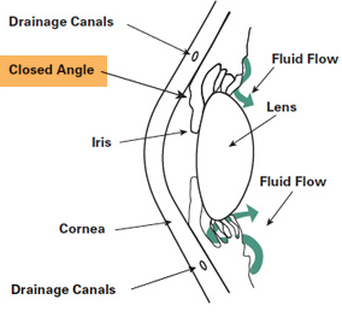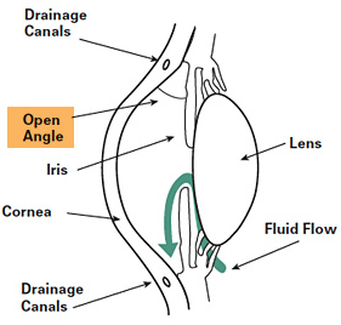Open Angle Glaucoma
- It is the most common type of glaucoma; It accounts for almost 80% of all Glaucoma cases
- Primary open angle glaucoma (POAG) is a type of the glaucoma with an open, normal appearing anterior chamber angle of the eye and raised eye pressure, with no other underlying disease.
- Although the angle of the eye where the iris meets the cornea is wide open, the eye’s drainage canals become inefficient and clogged over time. Eye pressure increases slowly and because of its gradual rise, patients do not feel any pain in the eye.
- Patients also do not notice any change in their vision initially because the initial loss of vision is of peripheral vision. Visual field loss is typically constricting from peripheral to the centre point. The visual acuity or sharpness of vision is only affected at the end-stage of the disease. The last minimal side vision would then disappear before total blindness ensues.
- High eye pressure causes chronic, progressive damage to the optic nerve and eventually patients suffer irreversible blindness.
- If there is an identifiable underlying cause for raised eye pressure; eg eye inflammation, eye injury or steroid use; this is termed Secondary Open Angle Glaucoma. If the eye pressure is normal, this is called Normal Tension Glaucoma.
|
Normotensive Glaucoma
This subtype of Open Angle Glaucoma tends to be missed by the non-experts because there is no ‘Red Flag' of high eye pressure!
-
The eye pressure is normal: 10 - 21 mmHg.
-
The signs and symptoms are similar to open angle glaucoma.
-
However, unlike Primary Open Angle Glaucoma; the visual loss typically affects the central vision even in the early stage. This means the impairment of vision occurs much earlier than primary Open Angle Glaucoma.
-
It is known to be associated with vasospastic diseases like Raynaud’s phenomenan and migraine. Patient with Sleep Apnoea Syndrome also has higher chance of getting this eye disease.
|
Angle Closure Glaucoma

Fig: Cross section of the front portion of the eye with Narrow Angle.
|
|
Patients have narrow or closed angle between the iris and cornea. Sudden blockage of the aqueous / fluid drainage can occur in the presence of narrow angle.
-
Patients usually come to Emergency Room with complaints of sudden onset of painful red
eye and blurry vision. They also see haloes and rainbow colours around a light. The pain could be so severe that it causes headache, nausea and vomiting. The eye pressure usually rises up to 50 mmHg or more! This eye emergency is called acute angle closure attack.
- It usually happens in the evening or at night. Our pupil enlarges in the dark and this bring the iris closer to the lens. This results in ‘pupillary block’ and the angle of the eye becomes closed thus causing sudden blockage of the aqueous flow. In the temperate countries, it tends to occur in the winter when the weather is dark and gloomy.
|
*However, some patients may have recurrent mild attacks that go unnoticed. They also present late like Open Angle Glaucoma.
Secondary Glaucoma
The eye pressure can also rises as a result of some uncontrolled eye diseases.
- Lens-induced Glaucoma
Occurs in hypermature cataract. Cataract that is too mature can results in high eye pressure. Cataract surgery at this complicated stages usually do not give good visual outcome because the optic nerve has already been damaged by high eye pressure.
- Neovascular Glaucoma
Occurs in uncontrolled diabetic and hypertension. This may also occur in some vascular diseases,with impairment of blood supply to the eyes like SLE and retinal artery occlusion. In this type of glaucoma, abnormal vessel grows in the angle of the eye and causes obstruction of outflow of the fluid/aqueous from inside the eye.
It usually cause very high eye pressure and responds poorly to pressure lowering eyedrops. Glaucoma Tube-Shunt surgery with implant is usually warranted to lower the eye pressure to prevent further damage to the optic nerve.
- Uveitic Glaucoma
Occurs in severe eye inflammation. The inflammatory cells block the dainage canals and result in high eye pressure.
- Glaucoma secondary to Injury
It can occur after open eye injury or close eye injury. Multiple mechanisms can be involved to cause elevation of eye pressure.
Bleeding and inflammation cells would clog the drainage canals and cause eye pressure to rise. A lens dislocated to the front by the injury could cause obstruction to the outflow of fluid from inside the eye. A blunt injury on the eyeball like shuttle cork injury or a hit by a blunt object can cause damage to the drainage canals with resultant high eye pressure.
- Glaucoma secondary to Medicines
Steroid-induced secondary glaucoma is quite common in places where patients could purchase medications freely over the counter without doctors’ prescription.
|
Commonly seen are cases of young adults with itchy eyes abusing steroid eyedrops with no consultations and monitoring by eye doctors.
Patients on oral or topical steroid for medical reasons should be referred to eye doctors for monitoring of eye pressure and to look for possibility of steroid induced glaucoma and steroid-induced Cataract.
Childhood Glaucoma
Childhood glaucoma is a type of glaucoma occurs in children; as young as 3-4 months old baby. The primary type – Primary Congenital Glaucoma is due to maldevelopement of drainage canals of the eyes.
Childhood Glaucoma can also occur in certain syndromic diseases such as Irido Corneal Endothelial Syndrome, Sturge Weber Syndrome, Neurofibromatosis and Peter’s anomaly.
Childhood glaucoma has different clinical presentations compares to glaucoma in adults. Small children do not complain. Their problems often been reported by parents who notice their child’s persistent tearing and shunting from bright light. The child’s eye may also appear hazy and larger than the normal eye. Childhood Glaucoma can involve one eye or both eyes.
|



